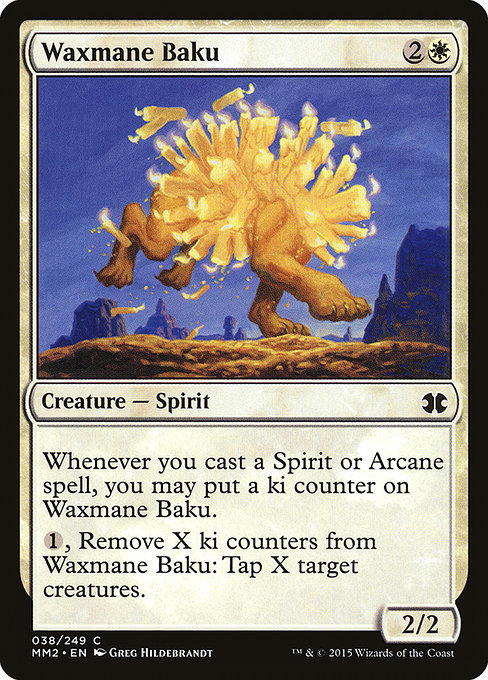
Image courtesy of Scryfall.com
Future directions for creative MTG design
Magic design has always thrived at the intersection of resource economies and tempo, and Waxmane Baku gives us a crisp lens to study where the game might head next. This little white creature—cast for three mana, a modest 2/2, and equipped with ki counters that unlock a powerful tapped-stopping effect—feels like a blueprint rather than a one-off. It asks: what if “build-up” resources could live in a creature’s chassis, ready to convert into bite-sized control when the moment demands? 🧙♂️🔥💎
Design snapshot: how a single card hints at a broader trajectory
- Counter-based energy: Waxmane Baku accumulates ki counters when you cast Spirits or Arcane spells. Those counters become a renewable resource you can spend later, turning simple tempo plays into postponed stoppers that bend the pace of the game. The mechanic nudges players toward plan-ahead play, where you invest in a stack of potential effects rather than chasing the immediate payoff every turn. 🎲
- Scalability within a small frame: The tap effect scales with X counters, letting you tailor the impact to the board state. This introduces meaningful decision points: how aggressively do you stock counters, and when do you unleash them? It’s a design pattern that invites more modular, flexible payoffs across future sets. ⚔️
- White’s evolving toolkit: This card nudges white toward a resource-building paradigm that complements its established strengths—protection, resilience, and controlling tempo—without losing its identity as a color of order and discipline. It’s a small pivot that suggests future white design could lean into recurring, reusable resources beyond the usual mana-base and card draw. 🧭
What Waxmane Baku teaches about the design space
There’s a tantalizing elegance in using a creature as a rolling reservoir of potential. By tying ki counters to the act of casting Spirits and Arcane spells, the design invites players to cultivate a thematic engine—Spirit tribal lines or Kamigawan-inspired Arcane callbacks—without needing a single, overt “new keyword” for every deck. The payoff is tactile: you glimpse the power curve and feel the satisfaction of converting a late-game board state into a controlled finish. It’s a concept that could ripple through future blocks: counters not just as a timer, but as a resource you actively build and burn to sculpt the battlefield. ⚽🧙♂️
Gameplay perspective: deploying this idea in formats you actually play
In Commander, Waxmane Baku could anchor a compact Spirit-based deck, leaning on a swarm of small creatures to stock ki counters and then spending them to tap down multiple threats—turning a parity board into a controlled win path. In draft or sealed, the card teaches patience: you may not get immediate value, but every Spirit or Arcane spell you cast nudges you closer to a decisive moment when you finally unleash the X-tap effect. For Modern or Legacy veterans, the idea hints at line-crossing designs that reward careful sequencing and timing, not just raw power. The result is a more dynamic spectrum of gameplay, where players balance building resources with the risk of overextension. ⚔️🧙♂️
Flavor, art, and the collector’s eye
Greg Hildebrandt’s illustration brings a sense of quiet, elemental energy to Waxmane Baku—an aura of discipline wrapped in otherworldly glow. The artwork reinforces white’s flavor of restraint, purity, and order while hinting at a latent, spell-powered storm beneath the surface. The card’s common rarity in Modern Masters 2015 also reads as a design invitation: a common that can enable uncommon plays when you connect the dots between Spirit, Arcane, and counter management. The visual design and the card’s theme celebrate the “craft” of MTG—where a simple 2/2 can become something more with the right build-around. 🎨
Collectors, reprints, and the value of design experiments
Waxmane Baku sits in a space that’s friendly to longtime collectors and curious players alike. As a common with a foil printing, it’s accessible, with price points reflected in digital and physical markets. The data hints at the economics of reprints and the enduring allure of a well-designed mechanic: cards that teach a concept—counters as a resource, scalable effects—often inspire future iterations that can become staples in both casual and competitive play. It’s not just about power; it’s about the idea—how a single card can seed a design conversation that reverberates through sets, formats, and even cross-format homebrews. 💎
Bridging to everyday play and cross-promotional ideas
As the MTG community ponders the next wave of design,Waxmane Baku reminds us that the best ideas often arrive wrapped in familiar themes: a white creature, a scalable payoff, and a trigger that nudges players to think multiple turns ahead. Whether you’re drafting, playing EDH, or curating a tabletop desk setup for weekend tournaments, thoughtful design conversations help keep the game fresh and familiar at the same time. On a practical note, when you’re setting up your play space and stream, a reliable, high-quality mouse pad can keep pace with the pace of your plays—check out the Ultra-thin Gaming Rectangular Mouse Pad to complement your strategy sessions. 🧙♂️🔥💎
For those who want to dive deeper into Waxmane Baku’s world, you can explore related cards and community discussions on Scryfall, gatherer, and EDHREC to see how this design concept has inspired players to think about counters, resource management, and interlocking tribal synergies in new ways. The future of MTG design may well be a conversation about how much you can build up before you unleash the payoff—and how cool it feels when the perfect turn finally arrives. 🎲